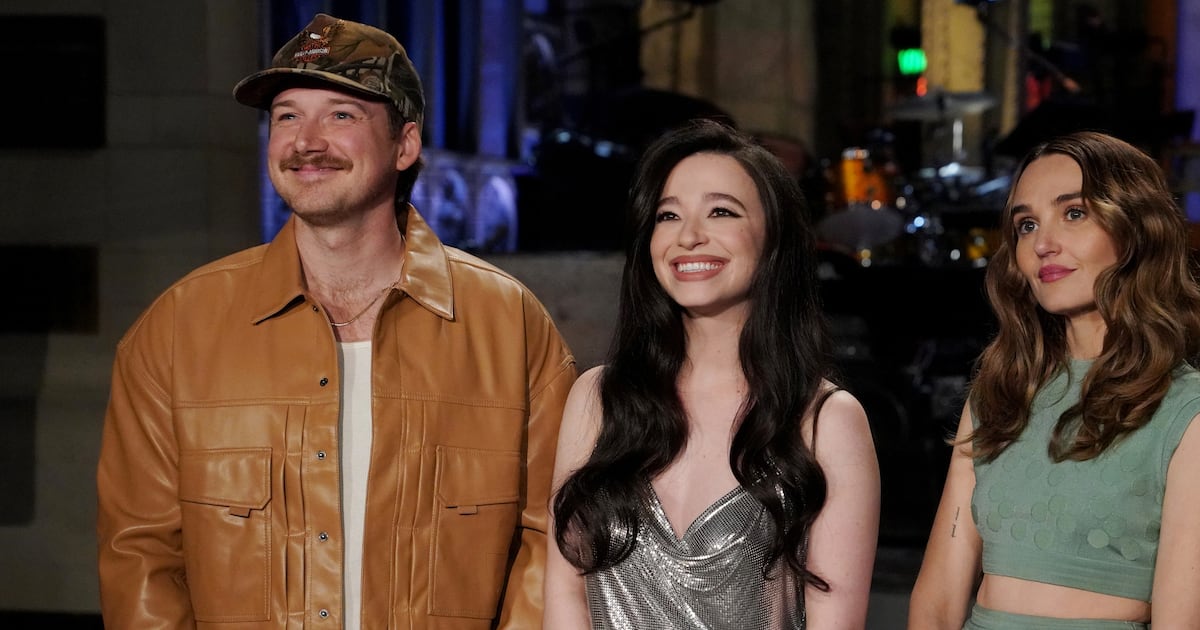To honor Taylor Swift’s latest rerecording, we’re celebrating 1989 (Taylor’s Version) Week at The Daily Beast’s Obsessed. That means we’re throwing it back to 2014, to re-live everything that Taylor—and the rest of pop culture—was up to.
As The Daily Beast’s Obsessed anticipates Taylor Swift’s latest re-recording with 1989 (Taylor’s Version) Week, it seems imperative to understand what Taylor Swift was up to when she released the iconic pop album on Oct. 27, 2014. What was going on in her life at the time? Where was she living? And more importantly, what—and who—were the songs inspired by?
I, for one, have found myself Googling the meaning behind every song as Swift rereleases her first six albums. Each new track isn’t as obvious as “Style,” a track clearly written about a certain ex with the last name Styles, (clever, clever), or “Dear John,” written about an ex whose last name rhymes with Taylor. But what about the others? More context is needed.
Before we get into the nitty-gritty of the album’s many meanings, though, it’s important to understand where Swift was at as a pop star when 1989’s big singles were hitting the charts. She had just released Red, as well as made herself a Hollywood name with The Lorax and The Giver. To kick off 2014, in March, the artist moved to New York, buying an apartment in Tribeca. (Not on Cornelia Street yet, though; that move came in 2016.)
Moving on, in April, the musician hired her famed publicist Tree Paine—a great idea, considering the (unearned) backlash she was soon to face when heading into her Reputation era. She stirred the pot with Katy Perry and made enemies out of future allies, like Nicki Minaj and Spotify. With October’s release of 1989, Swift removed her entire discography from Spotify and other streaming services that offered free versions, claiming that doing so resulted in miniature royalties for artists. (Swift reversed that decision in June 2017 ahead of Rep’s release, but I’ll never forget the pain of wanting to listen to “Out of the Woods” on repeat without being forced to use YouTube, draining my phone’s battery in the process.)
A happier memory is that 2014 was when Swift cultivated her glossy, powerful, A-lister squad. Just take a look at the “Bad Blood” music video to see the types of huge names Swift was brushing shoulders with: Cara Delevingne, Selena Gomez, and Blake Lively were some of the biggest names, and they remain among her closest friends. Many of these famous friends also attended her second-annual Fourth of July party, which became both epic and newsworthy.
Most importantly, the splashy cultural moment Swift conjured around the 1989 album release marked her complete transition from young country breakthrough to pop megastar. And a large part of that was due to the buzzy forces around her, inspiring her to mastermind (get it?) tracks like “Clean” and “Wildest Dreams”—this wasn’t an album about people like Taylor Lautner and John Mayer. Much bigger stars were involved in the 1989 lore.
So, click your pen and find a blank space in your journal—let’s write the names of everyone involved and how they influenced 1989 and the era surrounding the album.

Taylor Swift and Harry Styles are seen walking around Central Park on December 02, 2012 in New York City.
David Krieger / GettyHarry Styles
Swift’s famous relationship with the One Direction dreamboat actually took place before the start of the 1989 era in 2014—looking back on old photos, you can really tell the difference between pre-1989 and post-1989, thanks to Swift cutting her long locks into an iconic chopped bob, then growing it back out. Even so, he’s speculated to have inspired most of the tracks on 1989. Again: “Style.” Duh. The title is obvious in a cutesy way that still manages to make Swift look like a genius.
Other songs referencing Swift’s short time (a couple months) dating Styles aren’t as immediately obvious. In “I Know Places,” Swift sings, “They are the hunters/ we are the foxes.” In a photo of the couple that went viral in May 2014, Swift sported a memorable sweater with a fox on it. But who were the hunters? Paparazzi? Rabid fans? Either way, message received.
These are the most specific references to Styles on the album, but there are definitely others. They allegedly broke up on a boat, which Styles then jumped off before it had docked, possibly inspiring “All You Had to Do Was Stay?” In “Out of the Woods,” Swift mentions paper airplanes, which might be alluding to a paper airplane necklace both she and Styles wore. The list goes on: Any songs about love or breakups on 1989 belong to Styles.
Best of all, Swift ended the original release of 1989 on “Clean,” a song about finally being over someone and cleansing yourself of their existence—a truly empowering post-breakup anthem.

Karlie Kloss and Taylor Swift attend the 2014 American Music Awards at Nokia Theatre L.A. Live on November 23, 2014 in Los Angeles, California.
Kevin Mazur / GettyKarlie Kloss
Swift befriended Karlie Kloss after Kloss tagged her in a rather flirty tweet in 2012. The rest is history—for better or for worse, considering things have allegedly turned a bit sour. In the years that followed, they did everything together: They went on a road trip where Swift traced “Karlie hearts Taylor” in the sand; they ran errands together; and in interviews, Swift hinted that Kloss had nearly moved into her New York apartment. Understandably, fans started to believe these two were an item—they were pretty cute together, even as friends.
But in hindsight, none of the tracks on 1989 seem to be inspired by Kloss. Midnights’ “Maroon” and Evermore’s “Right Where You Left Me” both seem more related to Swift’s now ex-bestie than anything on 1989 does. The album focuses on handsome guys, knights in shining armor, and the stereotypical guy you date in your early 20s. (For Swift, that was Styles; the rest of us, maybe it was a guy who was not as handsome.)
That’s not to say Kloss wasn’t involved in the cultural moment surrounding 1989. She was a big part of Swift’s Victoria’s Secret Fashion Show appearances, girl squad, and move to New York. And without Swift’s major New York moment, in particular, there would be no 1989.

Yahoo Taping With Taylor Swift on August 14, 2014 in New York City.
Dimitrios Kambouris / GettyThe Big Apple
When any small-town girl moves to NYC, they’re inclined to gawk at the bright lights, meet new people, and try out a wild style. In 2014, Swift did all of the above, and even outlined her magical transition in 1989’s opening track, “Welcome to New York.” Swift took plenty of paparazzi photos—usually with Kloss in tow—while strutting the streets of New York with her girls, dining at plenty of local spots, and making herself known as the biggest star in the town.
Kloss was the one who took credit for convincing Swift to move to New York in 2014, persuading her to check out the West Village instead of London, where the singer had originally thought she might live. (She later decamped there to live with another British ex-boyfriend.) Styles is the inspiration for the songs, but Kloss—and New York—really pushed Swift into full 1989 mode.
Celebrity Beef
“Bad Blood” has become the ultimate feud banger, not only because it was written about an existing celeb spat, but also because it caused a fight to enter Swift’s orbit. In a Rolling Stone cover story from September 2014, Swift revealed that the track was about another female musician who she had once seen as a peer, until she started “stealing” away members of her touring team.
“For years, I was never sure if we were friends or not,” Swift said about the other artist (whom she kept anonymous) at the time. “She would come up to me at awards shows and say something and walk away, and I would think, ‘Are we friends, or did she just give me the harshest insult of my life?’”
This story was widely believed to be about Katy Perry, who shared an intriguing tweet the morning after. “Watch out for the Regina George in sheep’s clothing,” she wrote. The feud went on for quite some time—Perry later chimed in during Swift’s beef with Nicki Minaj, too— before the two officially made up in 2019’s “You Need to Calm Down” music video. Was it all a publicity stunt? Maybe. Did I still buy into all the petty drama? Absolutely.
The star-packed video for “Bad Blood” was nominated for Video of the Year at the 2015 Video Music Awards, a ceremony that caused a stir when Minaj’s “Anaconda” was snubbed. Minaj took to Twitter to shame the VMAs, particularly calling out women “with very slim bodies” who were nominated instead. Swift stepped in to ask Minaj not to pit women against each other, and the two squabbled. But at the actual VMAs, they set their differences aside and danced together.
Nowadays, Swift would never fight so publicly with her peers, neither on social media or in interviews. There’s that small rumored feud between Swift and Olivia Rodrigo, but it remains something fans whisper about—which pales in comparison to the volume of the fights that broke out between some of the industry’s biggest pop stars post-1989.
But these were only the start of Swift’s feuds. She again faced backlash after run-ins with Kim Kardashian and Kanye West just a couple years later, in 2016. Times were tough for our girl, but at least we got two damn good pop albums (1989 and Rep) out of the wreckage.











